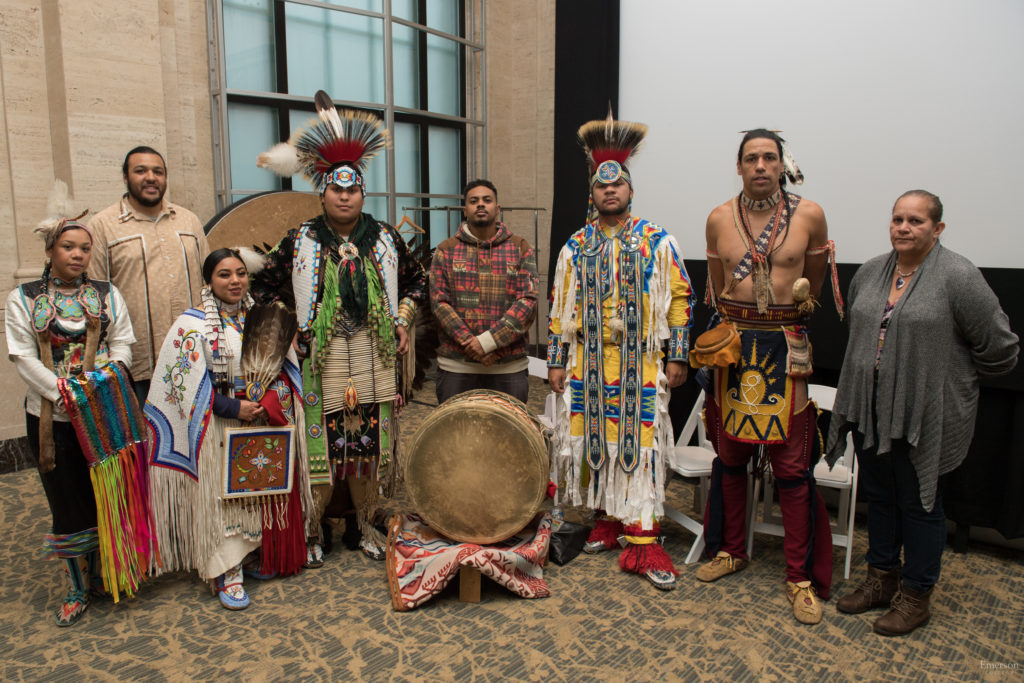Emerson event displays Native American diversity and resiliency
EMC_4584 Wampanoag Tribal Council, Native Americans, Performance, dance, School of Communications, Emerson College, Emerson, bordy theater, tribal Native American performers and educators from around new England brought a celebration of song, dance, and cultural identity to Emerson College as part of International Education Week. Performers introduced the history and purpose of dances and songs from Native American Nations…Performers: Wampanoag Tribal Council.Host: School of Communication with Jermey Heflin…Photo taken by Derek Palmer on 11/16/18 for Emerson College
November 28, 2018
Centuries after the first Europeans began colonizing what would become the United States, Native Americans, including the Wampanoag, the first tribe to have contact with the Pilgrims, continue to pass down their own customs and battle for the right to maintain their own institutions.
On Nov. 16, Emerson College’s School of Communication hosted a Native American Cultures Celebration to highlight the diversity of Native American cultures through song and dance and to raise awareness of current issues surrounding indigenous sovereignty and land rights.
“I think the most effective way of making change is to talk to each other and educate each other,” said Jessie Little Doe Baird, a member of Mashpee’s Wampanoag tribe who delivered the event’s keynote address. “I think there are times in humanity where we can be happy with the status quo. And I think there are very few of us who will see that in our lifetimes.”
Baird is the vice chair of the Mashpee Wampanoag Tribal Council and founder and linguistic director of the Wampanoag Language Reclamation Project. Mashpee is a town on Cape Cod.
“My blood and bones are from Mashpee,” she said, adding that her family has lived in the area for 12,000 years – the length of time separating the present from the events of the New Testament multiplied by six, she pointed out.
Jeremy Heflin, the coordinator for the event and Emerson’s Associate Director of English Language Learning, said he organized the celebration to educate attendees about land sovereignty issues still facing Native Americans and remind them that Native American peoples and cultures continue to exist. Also, he said, the event represents a chance to dispel the image of Native Americans culture as a uniform monolith.
“It’s been diverse, and it continues to be diverse,” he said. His father was of Cherokee descent, which encouraged his interest in the topic. He has a master’s degree in Native American religious studies.
This is the third year Emerson has held a similar event. The room was full to capacity, with around 75 people in attendance. Heflin said members of Native American cultural groups from MIT and UMass Boston came to participate.
Much of Baird’s talk focused on the Mashpee Wampanoag’s ongoing efforts to preserve their land under trust status, which allows the tribe to maintain its own police department and judicial system, write its own building codes and run its own school system. The tribe had its land placed under trust by the Department of the Interior in 2015, but earlier this year, the Department took the land out of trust status, prompting protests from members of the Wampanoag, other Native Americans and allies, along with calls from Massachusetts lawmakers to reverse the decision. Currently, the tribe is suing the federal government to have their trust status restored.
Baird has worked for decades to revive the Wampanoag language, which had no living speakers before her efforts began. Through the Wampanoag Language Reclamation Project, Mashpee Wampanoag preschoolers are taught their ancestral language and older students and adults are able to learn it as well.
Baird warned that taking the Wampanoag land out of trust endangers the tribe’s ability to educate their children in the manner they choose, with a curriculum that includes the Wampanoag language. She tied this to historic oppression of Native Americans by the U.S. government, which in the late 19th and mid 20th centuries took indigenous children from their families and placed them in boarding schools. At these schools, children were not allowed to speak their native languages, in an attempt to forcibly assimilate them into American culture.
“That is one of the most violent forms of oppression,” she said of deliberate actions to quash indigenous languages.
Baird’s talk was followed by a performance of traditional Native American dancing, singing and drumming. Annawon Weeden, an educator on Wampanoag, Narragansett and Pequot cultures, and his son Brian Weeden, an advisor for the United National Indian Tribal Youth Council, led a demonstration of Native American dances.
Five people, including Annawon, in full regalia performed several kinds of dances traditional to Native Americans from both New England and the Western plains, accompanied by Western-style drum and singing. Annawon and Brian explained the significance and purpose of the dances before each performance and encouraged the audience to participate in some of the dances.
“It helps us connect not only to the people but to the spirit world,” said Mish Conley, a member of the Narragansett tribe who performed as a drummer.
Dillon Lincoln, a freshman visual and media arts major at Emerson, attended the event with some classmates.
“The Natives were the first people here and I just feel like they don’t get much respect,” he said. “So yeah, I would love to learn more about the Wampanoag and what they’re doing to keep their culture alive.”
May Lui, a freshman visual and media arts major at Emerson, said she felt undereducated on issues surrounding Native Americans. She said there are few opportunities to learn about Native American culture and issues, explaining that she only found out about the ongoing struggles for land sovereignty for indigenous nations from having Heflin as her professor.
“It’s hard for me to believe that it’s still going on,” she said.







